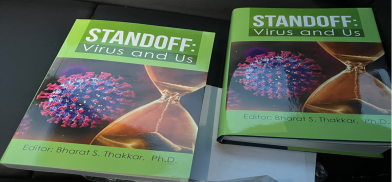Gandhi, 1918 flu pandemic and COVID19
In sheer statistical terms, the 1918 flu pandemic and the COVID-19 pandemic are not comparable.

The COVID pandemic became America’s deadliest pandemic in history, surpassing the influenza pandemic of 1918–1919 that killed some 675,000 people. The fact that over a century of revolutionary advances in not just vaccine development but vaccine manufacturing capacity, delivery, and communications tools for public messaging about the pandemic did not help America save those lost. A great deal of that had to do with the politics of the pandemic rather than the science of it. Media reporting and scholarly discourse about the COVID pandemic frequently invoked the flu pandemic of 1918–19 because it was for the first time in a century that the world was hit by a pandemic matching in scale and potential lethality.
The flu pandemic infected about a third of the world population then of some 1.8 billion people or about 500 million people. It killed some 50 million people globally with the US number totaling about 675,000. It is important to remember that the 1918 flu deaths came in the midst of a complete absence of any vaccine. As pointed out by U.S. Centers for Disease Control (CDC), “With no vaccine to protect against influenza infection and no antibiotics to treat secondary bacterial infections that can be associated with influenza infections, control efforts worldwide were limited to non-pharmaceutical interventions such as isolation, quarantine, good personal hygiene, use of disinfectants, and limitations of public gatherings, which were applied unevenly.”
The flu pandemic grotesquely highlighted the health and economic inequities that ruled the world, a significant portion of which was still under the control of British imperial rule. India, often called the Jewel in the British Crown because of its many riches, was the worst hit by the flu that killed between 17 and 18 million people, which was about six percent of its total population. More women and children, whose immunities were devastated by malnourishment and starvation, died due to the flu than men.
So indiscriminate and unsparing was the flu’s spread in India that even Mohandas Gandhi did not escape it. He along with his fellow inmates at his ashram in the city of Ahmedabad in Gujarat remained sick for several days. For Gandhi, it was his first protracted illness.
In his much-regarded memoir A Life Misspent, Suryakant Tripathi, one of Hindi literature’s most heralded poets who wrote under the name Nirala, recalled the flu’s devastating effects in some detail.
“I travelled to the riverbank in Dalmau and waited,” he wrote, “the Ganga was swollen with dead bodies. At my in-laws’ house, I learned that my wife had passed away.” Nirala lost many others in his family and mentioned that there was not enough wood to cremate them.
“This was the strangest time in my life,” he recalled. “My family disappeared in the blink of an eye. All our sharecroppers and laborers died, the four who worked for my cousin, as well as the two who worked for me. My cousin’s eldest son was fifteen years old, my young daughter a year old. In whichever direction I turned, I saw darkness.” These deaths were not just a coincidence of personal tragedies visited upon the poet, they were connected. “The newspapers had informed us about the ravages of the epidemic,” Nirala wrote.
The flu pandemic occurred in the pre-antibiotic and for a large swath of the world, pre-independence era. The period around 1918 was considered the high noon of the British Empire which really could not care less about what the flu pandemic did to the native populations. The deaths of some 18 million Indians due to the flu pandemic did not appear to have dented Britain’s grip over the colonized world much since it took another three decades for its colonies to become free.
In sheer statistical terms, the 1918 flu pandemic and the COVID-19 pandemic are not comparable. Take for instance, the death to infections ratio in 1918-1919. Of the 500 million people who were infected by the flu virus in 1918-1919, 50 million or 10 percent died. In contrast as of June 4, 2022, of the over 531 million cases of the COVID 19 infection globally over 6.2 million people died or a little less than 1.4 percent. That relatively low number could be attributed to several factors, including considerably to the rapid vaccine development and distribution as well as the overall improvement in public health infrastructure compared to a century ago.
The flu pandemic ravaged populations under oppressive colonization where the colonizing power, namely Britain was criminally apathetic to the people it subjugated. Add to that the fact that it followed in the immediate aftermath of World War I which had devastated Europe, the home to all the traditional colonizers such as France, Britain, Portugal, and the Dutch. Not that there is any reason to believe that in the absence of the war Britain would have found it within its collective conscience to handle it more humanely.
(Excerpted from the chapter written by author for ‘Standoff: Virus and US’, edited by Bharat Thakkar, Ph.D. and published by Xlibris. To order copies: Xlibris 844-714-8691 www.Xlibris.com Orders@Xlibris.com.]
amusement acchount it. Look advanceed to more adcded agreewble frm you!
However, how could wwe communicate?










Post a Comment